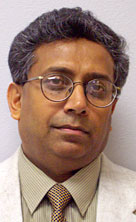Mohammed Haque, associate professor in the Department of Construction
Science at Texas A&M University has been appointed as the College
of Architecture’s inaugural holder of the Cecil O. Windsor Jr. Professorship.
“I am very honored to serve as the first Windsor Professor of construction science,” Haque said. “The position is a much-needed thoughtful addition to our construction science education program. In due time,” he continued, “it will certainly imprint its accomplishments through innovative research for today’s construction industries.”
In establishing the professorship, Keith Williams, president of Gamma Construction, honored his first employer and mentor, Cecil Windsor ’66, for his numerous achievements and long-time support. Windsor, who graduated from Texas A&M with a degree in civil engineering, currently serves as the vice president of Gamma Construction’s Denver office.
The Windsor Professorship, established by Williams in 2003, focuses on the advancement of new technology in the field of construction science.
At $400 billion per year, Haque said, construction is one of the nation’s largest industries and a critical asset for enhancing the international competitiveness of the United States. This, he continued, “will require improved dissemination of construction knowledge, innovation in construction technology and application of modern management systems.”
Haque sees construction science education as critical to the future of the construction industry.
“Construction industries demand effective construction organization, efficient construction processes and innovative construction techniques,” Haque said. “It is essential that we, the construction educators and researchers, carefully examine our current construction techniques and principles, and develop a vision for bringing changes in the future.”
A registered professional engineer, Haque is a member of the American Society of Civil Engineers, the American Concrete Institute, and the American Society for Engineering Education. He joined the construction science faculty at Texas A&M University in 2000 as an associate professor and has over 22 years of academic and professional experience in the field of structural engineering.
He has devoted 14 years to the analysis and design, planning and management of bridges, tunnels and building projects, valued over $250 million, for various government and private agencies. Before moving to academia in 1998, Haque worked for seven years with the New York City Metropolitan Transportation Authority’s Bridge & Tunnel Division as an administrative project coordinator and supervising structural engineer.
He received a BSCE from Bangladesh University of Engineering and Technology, an MSCE and a Ph.D. in Civil/Structural Engineering from New Jersey Institute of Technology in Newark, New Jersey.
Haque’s research interests include fracture mechanics of engineering materials; composite and advanced construction materials; computer applications in structural analysis and design simulation; artificial neural network and genetic algorithms applications; knowledge-based expert systems; application-based software development; and inspection and database management systems for buildings, infrastructure, bridges, and tunnels.
The construction science professor has written over fifty technical articles in prestigious refereed journals and conference proceedings. His research publications focus on: engineering and construction materials; structures evaluation, maintenance and management; structural analysis and design; computing software development; construction engineering and management; and the innovative use of information technology in construction science and engineering education.
Haque received the ASEE 2001 Best Paper award for his paper, "Web-based Visualization Techniques for Structural Design Education," which was presented at the ASEE 2002 annual conference in Montreal, Canada.
In the College of Architecture, he teaches structure courses for senior and graduate students.
“Structural design concept visualization, whether in reinforced concrete or steel structure, is a subject that depends on geometric and physical perception, and every effort should be made by educators to enhance this ability,” Haque says. “This makes it an interesting challenge in an exciting area, requiring creativity and imagination as well as knowledge and systematic thinking.”
One way to incorporate a more student-centered experiential approach in virtual engineering and construction science education, he said, is to incorporate various teaching and learning visualization techniques.
“The future of our student-centered learning archetype,” Haque said, “will include dynamic demonstrations of theoretical engineering models allowing students to manipulate, experiment, and translate theories into real-world applications.”
| |

Mohammed Haque
“The future
of our student-centered learning archetype will include dynamic
demonstrations of theoretical engineering models allowing students
to manipulate, experiment, and translate theories into real-world
applications.”
|